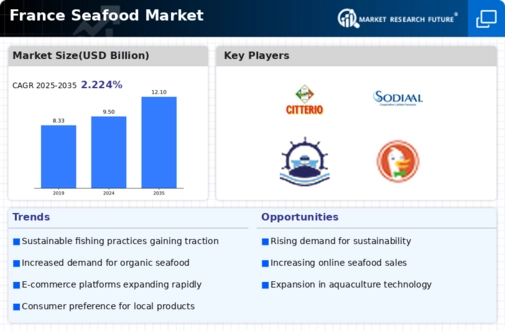Regulatory Changes and Compliance
The seafood market in France is significantly influenced by regulatory changes aimed at ensuring food safety and sustainability. Recent legislation has introduced stricter guidelines for fishing practices and aquaculture, which may impact supply chains and operational costs. Compliance with these regulations is essential for market players to maintain their licenses and avoid penalties. For example, the European Union's Common Fisheries Policy emphasizes sustainable fishing practices, which could lead to a reduction in overfishing and promote the long-term viability of fish stocks. As companies adapt to these regulatory frameworks, they may need to invest in sustainable practices, which could initially increase costs but ultimately enhance their market position and consumer trust in the seafood market.
Rising Consumer Demand for Seafood
The seafood market in France experiences a notable increase in consumer demand, driven by a growing preference for healthy and protein-rich diets. Recent data indicates that seafood consumption has risen by approximately 10% over the past year, reflecting a shift towards more sustainable and nutritious food options. This trend is further supported by the increasing awareness of the health benefits associated with seafood, such as omega-3 fatty acids and essential vitamins. As consumers become more health-conscious, the seafood market is likely to see continued growth, with an emphasis on fresh and responsibly sourced products. Retailers and suppliers are adapting to this demand by enhancing their offerings, which may include a wider variety of seafood products and improved supply chain practices to ensure freshness and quality.
Impact of Climate Change on Seafood Supply
Climate change poses a significant challenge to the seafood market in France, affecting fish populations and distribution patterns. Rising ocean temperatures and changing salinity levels can lead to shifts in species migration, impacting availability and pricing. For instance, certain fish species may become less accessible, leading to potential shortages and increased costs for consumers. The seafood market must adapt to these changes by exploring alternative sourcing strategies and investing in aquaculture practices that are resilient to climate impacts. Additionally, stakeholders are likely to engage in research and collaboration to develop sustainable practices that mitigate the effects of climate change. As awareness of these issues grows, the seafood market may see a shift towards more sustainable and adaptive approaches to sourcing and production.
Growth of Local and Artisanal Seafood Producers
The seafood market in France is witnessing a resurgence of interest in local and artisanal seafood producers. This trend is characterized by consumers seeking fresher, high-quality products sourced from nearby waters. The rise of farmers' markets and local seafood festivals has contributed to this movement, allowing small-scale producers to showcase their offerings. Data suggests that sales from local seafood producers have increased by approximately 15% in the past year, indicating a shift in consumer preferences towards supporting local economies. This growth not only benefits local fishermen but also enhances the seafood market by diversifying product offerings and promoting sustainable fishing practices. As consumers become more aware of the environmental impact of their choices, the demand for locally sourced seafood is likely to continue its upward trajectory.
Technological Advancements in Seafood Processing
Technological innovations play a crucial role in shaping the seafood market in France. Advances in processing techniques, such as improved freezing and packaging methods, enhance product quality and shelf life, thereby attracting more consumers. The implementation of automation and artificial intelligence in processing facilities has led to increased efficiency and reduced operational costs. For instance, the adoption of smart sensors in monitoring seafood freshness is becoming more prevalent. These technologies not only ensure that products meet safety standards but also cater to the growing demand for transparency in sourcing and production. As these advancements continue to evolve, they are likely to bolster the competitiveness of the seafood market, enabling suppliers to meet consumer expectations more effectively.















Leave a Comment